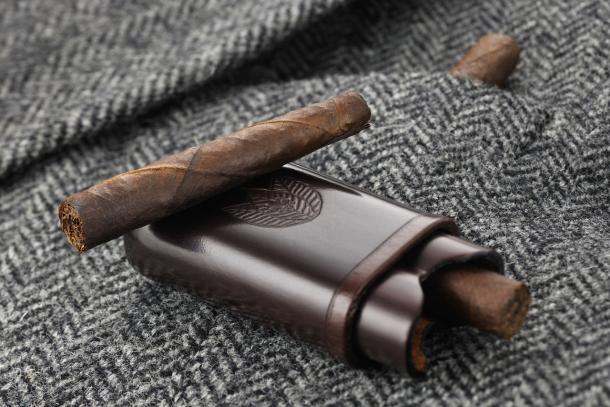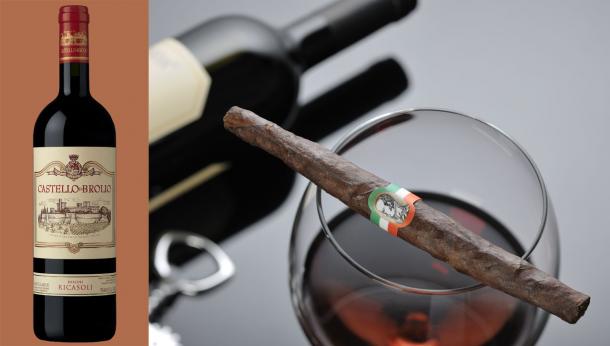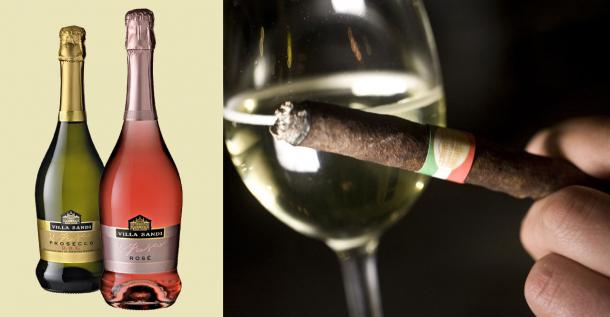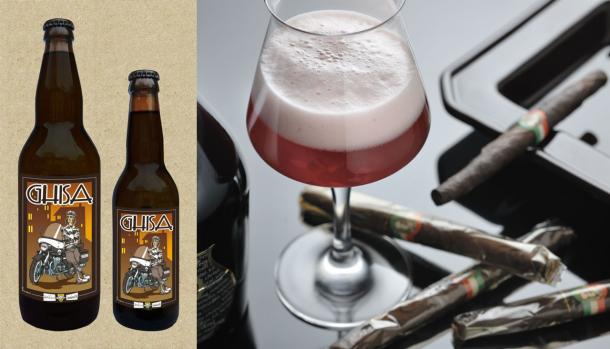Be Bold: Pairing Wines and Liqueurs with Cigars
While the world of wine and food pairing is vast and complex as it stands, there is now a growing trend in Europe to pair wine with cigars…so whether you’re a neophyte or an appassionato, here are some enterprising ideas.

The classic and most acclaimed combinations are Cuban or Tuscan cigars with sparkling whites or distillates and liqueurs, such as calvados (an apple brandy), whiskey, rum or cognac, working to combine the strong aromas of the alcoholic drink of choice with the peat, smoked or coffee flavors of the cigar itself. A closer look at how cigars are being enjoyed today in Italy shows us a fresh approach to an old tradition.
The most loved Italian cigar is the Toscano, which is produced in Lucca, Tuscany, by Manifatture Sigaro Toscano. That general family name covers several industrial made brand variations, which have decidedly fuller flavors, and some special hand made versions, with lighter, purer and more persistent flavors, like the Garibaldi, Modigliani or Soldati, all of which carry the name of some of Italy’s best known historical personalities.
As a first combination I suggest a Sigaro Toscano called il Moro, hand made and aged 12-18 months, matched with a vintage 2007 Chianti Classico DOCG “Castello di Brolio” by Ricasoli, which has great aromatic complexity. The chocolate, coffee and spices on the palate go well with the quiet yet strong flavor of il Moro, and the elegant tannins of this Chianti prevail with a long finish.

If you like a lighter cigar, I suggest a Toscanello Aroma Vaniglia, one of the most widely known Italian cigars, with a nice balance of spicy and sweet (and appreciated also by women), matched with some high quality “bubbly”, like the Prosecco DOC Treviso or Spumante Rosato “Il Fresco” by Villa Sandi. To the eye, the Villa Sandi’s Rosato has light pink and bright nuances from the use of the grape skin in the fermentation process. Fruity and floral to the nose with delicate notes of golden apple and mountain wildflowers, it compliments the vanilla of the cigar perfectly. The Prosecco, with its sparkling dry, fresh and fruity taste and a harmonious aftertaste, it goes very nicely too with a Toscanello Vanilla – a perfect combination for a toast, a way to relax after a successful meeting, or just a fun date.

If you are not ready to match cigars with wine, but are looking for something unique and international, you can try a Romeo Y Julieta, a type of cigar produced both in Cuba (by Habanos SA) and in the Dominican Republic (by Altadis SA, a division of Imperial Tobacco), with a very special Italian brandy, precisely a vintage 1988 of “Antico Brandy Italiano” con selezione di tabacco toscano, aged 21 years, by Villa Zarri. This is not simply a brandy, but it is sometimes considered a refined “tobacco drink”, because of the use of Tuscan grown tobacco leaves in the distillation process. It has sweet notes of raisin, vanilla, barley and licorice in the nose. Also present are hints of date, rosewood and an echo of smoking tobacco. The palate is then pervaded by intense tones of Tuscan cigar, raw leather and black pepper. This brandy demands an excellent cigar, whether Cuban or Tuscan is your preference.
![Certain things never go out of style: Romeo Y Julieta cigars and Italian brandies are a new take on a classic pairing. © Villa Zarri and [cc] by Geographer, via Wikipedia Romeo Y Julieta cigars paired with Italian brandy](http://www.made-in-italy.com/new/wp-content/uploads/2018/03/cigars-and-italian-brandy.jpg)
![A bold match for a man who doesn’t mess around: Cohiba and Italian grappa. © Centopercento and [cc] by Vonlampard via Flickr Cohiba cigar paired with Italian grappa](http://www.made-in-italy.com/new/wp-content/uploads/2018/03/cigars-and-italian-grappa.jpg)

So now, if all these different pairings have aroused your interest, why not try a course to become a catador, or cigar taster, and you can unite two very nice Italian passions, as wine and cigars?
Related news stories:
- My Rome Trip: Learning What an Armani Suit Can Do for a Guy
- Coated in Crocodile or Ostrich: Bespoke Bicycles Made in Milan
- Watch Collector Secrets: Luxury Italian Timepieces for Men
- Two Italian Boyhood Friends Become Menswear Trend Setters
- Pirelli’s Graphic Design: More Than Just a Pretty Face
- When Wine Barrels Die: Reborn as Design Furniture
- Lake Como: What Keeps George Clooney Coming Back?
- A Suite Ride: Ramaciotti’s Maserati Quattroporte
- Mens Trends 2013: Costume National Brings It, Swagger Included
- Mens Trends 2013: Borsalino Hats for Boardwalk Empire Men
- Mens Trends 2013: Bottega Veneta, Pure Sartorial Elegance
- Mens Trends 2013: Ferragamo, Explosive Color, Ultra Urban
- Mens Trends: Trussardi, Sleek Outdoorsmen, Man Bags
- Mens Trends: Brioni’s Slim Suits & Secret Service Looks
